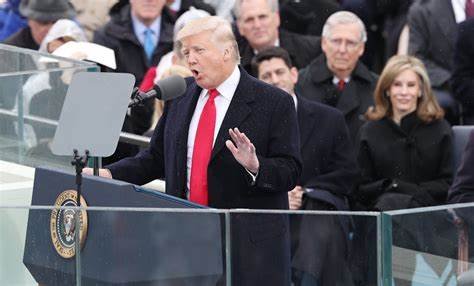President Donald Trump’s second inaugural address, delivered under unusual circumstances, was a pivotal moment in American history. With now-former President Joe Biden seated just feet away, Trump used the opportunity to lay out his agenda while delivering sharp criticisms of the outgoing administration. Here are four major takeaways from the event:
Trump wasted no time outlining his priorities, focusing on immigration, energy independence, tariffs, and cultural issues.
- Immigration and Border Security: Trump promised immediate action, including declaring a “national emergency at our southern border” to halt illegal immigration and deport criminal immigrants. He emphasized his commitment to ending the “catch and release” policies of the previous administration and reinstating the “Remain in Mexico” program.
- Energy Policy: Trump vowed to rescind the Green New Deal, declare a “national energy emergency,” and eliminate mandates promoting electric vehicles, emphasizing consumer choice in products. He also criticized climate change policies and pledged to support traditional energy sources such as coal and oil.
- Economic Measures: Proposing an “External Revenue Service,” Trump pledged to impose tariffs on foreign goods to bolster domestic manufacturing and economic prosperity. This plan would aim to reverse the trade imbalances with countries like China, focusing on the importance of fair trade deals.
- Cultural Issues: Trump reiterated his stance on gender policies, promising to make it U.S. policy to recognize only two genders: male and female. This aligns with his broader agenda to challenge progressive policies, especially on issues related to transgender rights.
These policy priorities aligned with his core base’s expectations, underscoring his continued focus on culture wars, economic nationalism, and a commitment to American values.
Notably absent from Trump’s official speech were discussions of Jan. 6, his legal challenges, and his plans for political retribution—though these were addressed later in his informal remarks.
- Political Retribution: Trump hinted at his intent to rebalance “the scales of justice” and end the “weaponization” of government but avoided specifics in his formal address. His comments implied that his administration would actively seek to target those he views as political enemies, particularly those involved in the investigations against him.
- Jan. 6 Convictions: While omitting direct references during his address, Trump later pledged to pardon many convicted individuals involved in the Capitol riots, an issue polarizing even among Republicans. The move to pardon these individuals highlights his ongoing support for those he perceives as his political base.
- Election Claims: Trump refrained from discussing his false claims of a stolen 2020 election during the formal address but doubled down on them in off-script remarks, reaffirming his belief that 2024 was “too big to rig.” His refusal to concede the legitimacy of the 2020 election remains a key point of contention in American politics.
By separating his formal address from his informal remarks, Trump balanced statesmanship with red meat for his supporters.
Despite calling for unity and pledging to be a “peacemaker,” Trump used the occasion to harshly critique Biden’s presidency, targeting both domestic and foreign policies.
- Domestic Failures: Trump lambasted the government for its handling of natural disasters, crime, and public health, asserting that it “can no longer deliver basic services in times of emergency.” He contrasted this with his own handling of crises during his first term, suggesting that Biden’s approach had failed to meet the needs of American citizens.
- Foreign Policy: He criticized unlimited funding for Ukraine while neglecting American borders and accused Biden of prioritizing global interests over domestic needs. He pointed out the inefficiency of U.S. government spending and called for a shift in foreign policy priorities that would focus on American interests.
- Education and Culture: Trump accused the education system of fostering shame among American children and pledged to restore pride in national values. He also attacked Biden’s policies on critical race theory and other progressive educational initiatives, promising to push back against such reforms.
These pointed critiques, delivered with Biden and Vice President Kamala Harris present, set a combative tone for the new administration. Trump’s speech exemplified the deep political divide in America and signaled the contentious battles that lie ahead.
While Democrats participated in the inauguration to uphold the tradition of a peaceful transfer of power, their reactions revealed underlying tensions.
- Awkward Moments: Trump’s remarks about Martin Luther King Jr. Day and his proposal to rename the Gulf of Mexico to the “Gulf of America” drew visible reactions from Democrats, including a bemused smirk from Biden and laughter from Hillary Clinton. These moments illustrated the profound ideological divide between Trump and many Democrats.
- Fear of Retribution: Many Democrats remain wary of Trump’s return to power, fearing his rhetoric about “rebalancing” justice and pardoning Jan. 6 convicts could escalate divisions. His remarks further highlighted the partisan polarization that continues to dominate American politics.
- Public Sentiment: While Trump emphasized his improved standing with Black and Latino voters, his polarizing policies and rhetoric continue to evoke strong responses from both supporters and critics. His rhetoric about achieving success with these demographics was tempered by the harsh reality that his presidency remains divisive.
The inauguration, held on Martin Luther King Jr. Day, highlighted the stark contrasts between Trump’s vision and his predecessors, foreshadowing a contentious political landscape ahead. The ongoing rift between the two political parties will likely define the next four years.
President Trump’s second inaugural address marked a defining moment in American political life. By balancing his formal speech with informal remarks to his base, Trump was able to communicate his aggressive agenda, mixing bold promises of action with direct critiques of the Biden administration. With a focus on immigration, energy independence, and cultural values, Trump signaled a return to the themes that have shaped his political identity. As Trump embarks on his second term, his approach to governance will continue to divide the nation, ensuring that his presidency will be as contentious as it is transformative.



